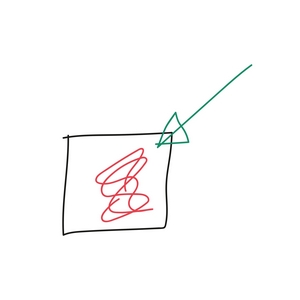In general, individuals who have not finished responding (see unfinished business) to an earlier threat in life are left with baggage in their nervous system. This either speeds them up or slows them down, leading to them over or under-reacting to new stimuli in life, which we sometimes call triggers if they lead to one of these out-of-scale reactions. Sometimes, however, we get it just right, and so we have three basic ways of reacting to a stimulus, or trigger. We can draw these three different ways of reacting as three different diagrams like below. The red squiggle represents your baggage, the green arrow is a trigger, and the red arrow is your output, or reaction.
Overreaction:

Under-reaction: (In this diagram, the box represents little to no reaction, where the energy is instead internalised.)

Just right, or Goldilocks reaction:

If we go with the idea that any one person can be represented by any one of these diagrams, then we can begin to build a picture of the kinds of relationships we have in life. These can be romantic relationships, or any type of relationship; family, friends, colleagues. We sometimes find that the dynamics discussed here are most noticeable or extreme in romantic relationships, so that’s a good focus to illustrate the points, but the analysis works for everyone.
If you have three kinds of people, then you can have six kinds of relationships.
Goldilocks with Goldilocks
I want you to imagine the people represented in the diagram above standing next to each other. In this example we are going to take one just-right reacting person and place them next to another just-right reacting person. Then I want you to imagine that you are going to turn them into an animated cartoon. What happens to those arrows? How would the cartoon develop over time? What would get bigger and what would get smaller?

They have the space and regulation to wobble gently back and forth. They can occupy adjacent space together, and it seems to be easy. Coming and going is no problem. It is safe to be close and also safe to move a little further away. If you have ever had a really great housemate, I think this is the kind of relationship you may have had. It’s easy to talk through problems together, and you can come and go without triggers and reactions. Either there is no baggage, or you just don’t set each other off.
I don’t know about you, but I feel instantly more relaxed, just looking at the diagram above. This is the world we all want to live in. Even if we have lots of baggage and a dysregulated nervous system, we can start to make this kind of relationship happen for ourselves and for others with boundaries and containment. It turns out that it is possible to fake it until you make it. We can choose to begin that journey today. It might look like this:

Does this remind you of anyone?
These two people have dysregulated nervous systems but by using boundaries and containment, they are simulating the behaviour of people with no baggage.
Both of these people might have been in the types of relationships that are combinations of different types of reaction, for example where someone was over-reacting or under-reacting, but, by changing how they manage their nervous systems, perhaps even just a little, they have been able to move into a relationship that seems to be perfect, at least on the outside. It takes a lot of work on the inside, but the rewards are worth it.
When people can come together in safe, manageable relationships like this, they have the potential to hold each other in a way which allows their nervous systems to settle and to heal. All kinds of relationships now become possible. And it is never too late to start.
Originally published at: https://www.benjaminfry.co.uk/post/22-blissful-happy-relationships/


